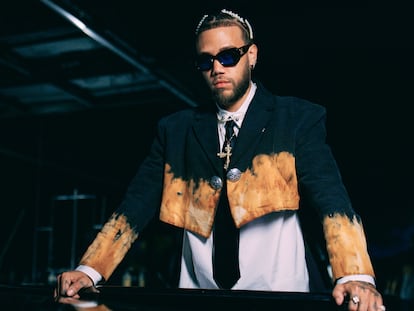From Maluma to Bad Bunny: The ‘Latin lovers’ that have conquered the world
Latino artists are the most visible faces of a cultural phenomenon that runs deep

“¡Pero qué chimba, chimba de vida! ¡Estoy viviendo la life que quería! ¡Aquí estoy viviendo chimba de vida!” Such was the triumphant refrain of Karol G upon rocking Madrid’s Santiago Bernabéu stadium last summer on four consecutive nights, with an audience of around 60,000 at each gig. If Spanish listeners are familiar with the word chimba, Colombian Spanish for something very cool, it’s because of her—or perhaps her countryman Maluma, who is always singing about his parceros, national slang for close friends, and their chimbitas. “¡Qué chimba parce!” is a very Colombian phrase that works to describe anything relatively positive, from a cocktail to a film. It’s the equivalent of saying “me lo estoy gozando,” another very Latin American way of expressing supreme happiness that has wound up insinuating itself within the Castilian Spanish of Spain.
Effectively, Latino musicians are living the life they always dreamed of, which for many of them involves jetting between Miami and Madrid, that unexpected European mecca of perreo, where thousands of their fans — keep in mind that the Spanish capital is home to more than a million Latinos — dance to songs with studied thrusts of well-toned pelvises and gluteal muscles. Spaniards themselves may possess a more rigid physiognomy, but they learn fast, and the two groups manage to fill clubs in which one in every three songs hails from the urban genre.
That umbrella of sounds, among which reggaeton is king, does indeed account for more than 35% of the music in Spanish nightclubs. In 2024, Puerto Rican artist Myke Towers was the most-listened-to artist in Spain, according to Spotify. Bad Bunny occupied the second spot on that list, followed by Colombia’s Feid and then Spanish reggaeton and trap artists Saiko from Granada and Quevedo from the Canary Islands. Over this boy’s club reigns Karol G, whose Si antes te hubiera conocido was the country’s most-played song of last year.
Urban music largely sings of a male-dominated, sexually explicit and foul-mouthed world. Most of its lyrics would not stand up to gender-based analysis, its protagonists’ attitudes are defiant, and songs can read like catalogues of fashion brands, luxury hotels, sports cars and fine jewelry. If J. Balvin sings about a Bond perfume, that fragrance rises ipso facto up the list of desirable objects. Two summers ago, an extremely discreet Bad Bunny visited Group Isolée’s display in Puerto Banús’s Corte Inglés department store, going unnoticed by everyone, including the saleswoman from whom he purchased a bottle of Marly Parfums’ Layton. That night, the singer posted his purchase to social media, setting of one of the most spectacular instances of going viral in the history of men’s perfumes. Isolée would only later figure out the chain of events that had led to its sales boom.
But the Latin vibe has not been driven by scent alone. The normalization of an aesthetic that would have been considered radical a few years ago confirms the current global superstar status of reggaeton and trap musicians. Latino haircuts transcend social class in Spain, with shaved areas that reveal the scalp and etched designs that can cover one’s entire head. The look is augmented with notches to the eyebrow that imitate the appearance of scars, creating the appearance of a tough guy who doesn’t hide his war wounds. This urban genre aesthetic is topped off with elaborate tattoos and chains and rings on several fingers. “Now there are two looks, you’re either cayetano [preppy] or you’re urban,” sums up Arleth Rojas, a Honduran journalist who has lived in Madrid for several years.
At The Beauty Concept, a salon and aesthetic medicine facility that oversees the spa at the Mandarin Oriental Ritz in Madrid, staff have observed how young men are shifting their aesthetic to look like their Latin idols. The center’s director, Paz Torralba, lists the most-copied attributes of each singer: “Rauw Alejandro’s smile and teeth, Bad Bunny’s jawline, Daddy Yankee’s cheekbones, Ozuna’s haircut and Maluma’s torso and abdomen definition, after he slimmed down.”
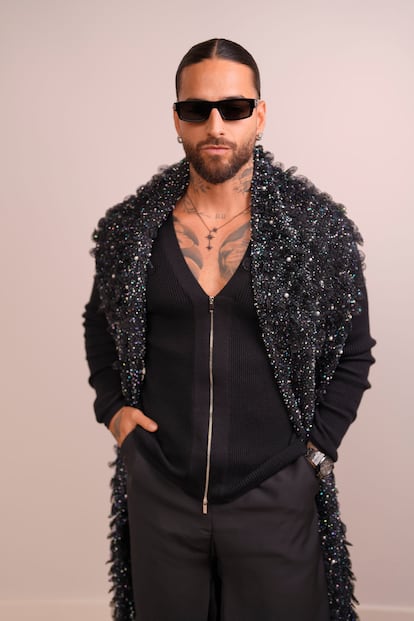
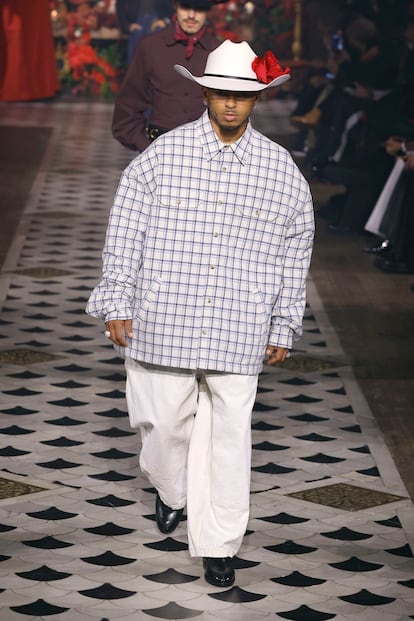

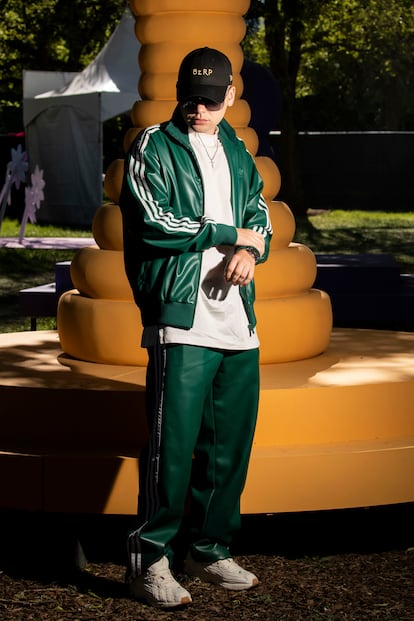
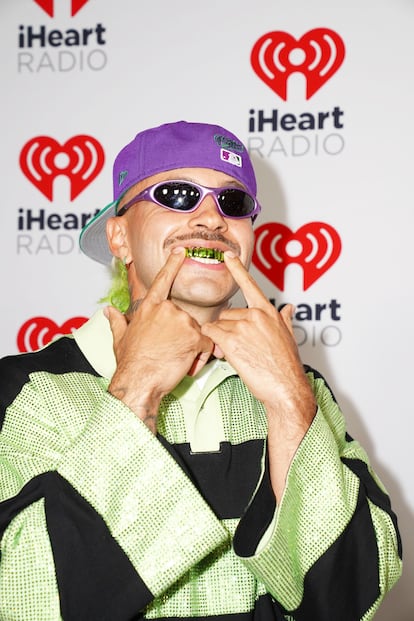
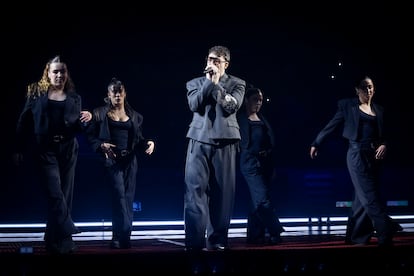

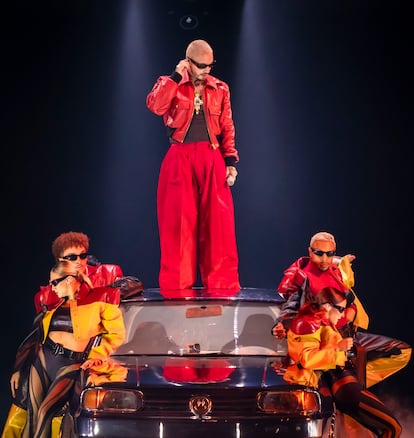

Andrés García Maso of Cali, Colombia, arrived in Madrid in 2012 and taught Zumba classes in gyms across the city. Today, he is the creator of the Instagram account Mi Bello Madrid, which has 305,000 followers. “When I got here, I might hear salsa at a wedding, almost always Vivir mi vida by Marc Anthony. Now I can dance to songs from Cali at any party in Madrid,” he says. As a personal trainer, he can testify to how workout routines have changed over the years to achieve certain physical ideals. “There is more importance placed on the legs and shape of the glutes. Us Latinos are concerned about the lower half,” he says.
On a hot night in September 2024, the crowd at Fitz Club Madrid on Calle de la Princesa was waiting for Quevedo. With no prior warning, the singer showed up with Rauw Alejandro, and they were looking for an after-party. “It wasn’t the official party, but they did end up here,” says Carlos Rubio, musical director of Grupo Sounds, which owns the club. He adds, “Obviously, these musicians are primarily looking to play at WiZink or three or four nights at [Santiago Bernabéu Stadium], but they come through and sing for free for their friends. Things are happening in Madrid that before, only happened in Miami,” he reflects. That must have been the thought process that led the owners of Perro Negro to open their first location on the other side of the Atlantic in Madrid’s Salamanca neighborhood. Perro Negro is a Medellín venue that Bad Bunny and Karol G have cited in their songs as the mecca of reggaeton.
Fitz, which is strategically situated alongside Madrid’s Plaza de España, and which has another large location in Marbella, was a pioneer in bringing genre greats like Ozuna, Jhayco, Myke Towers and JC Reyes. The strange thing is that when it opened in 2022, it was designed to be an electronic music venue.
Spain, and specifically Madrid, is experiencing a phenomenon that experts have dubbed the “globalization of Latinidad”, and which, according to a study by the country’s Nebrija University, is being expressed in shifts in attitude towards reggaeton and other urban genres. According to the report, three factors have set the stage for this widening of acceptance: the changing socioeconomic position of the new artists, many of which have studied at universities and have larger purchasing power; the elevation of the genre through transnational collaborations between Spanish and English-speaking artists; and the dual digital identity of singers who know how to simultaneously be influencers and masterful content creators on platforms like TikTok.
The 2023 Latin Grammy ceremony in Seville was the coming-out party of a loud and well-off Latin community who feels very much at home on that side of the Atlantic, and has brought the many purveyors of its lifestyle over: hairdressers, stylists, decorators, financial advisors, gallerists and even restaurateurs. The latest iconic Latin eatery to make the leap is Peruvian Gastón Acurio’s La Mar, which is opening a location in front of the Bernabéu because, as the chef confirmed to EL PAÍS, “many of my regular customers have recently moved to the city.” A similar argument is put forward by Dr. Alan González, a plastic surgeon who opened a Madrid branch of his Care Me aesthetic clinic a month ago. (The other locations are in Cali, Barranquilla and Bogotá.)
Experts at the Nebrija Observatory for Spanish say that not since 1950s mambo mania had a genre of Latin-Caribbean aesthetics with lyrics in Spanish achieved such mainstream acceptance. The institutionalization of perreo was confirmed in 2023 when Bad Bunny appeared in Time, dubbed “a legitimate heir to Frank Sinatra.” For the first time in 100 years, the magazine featured all-Spanish text on its cover in the form of a very Bad Bunny quote: “No voy a hacer otra cosa para que a ti te guste”. [“I’m not going to do something different to make you like it.”] Need we say more?
Sign up for our weekly newsletter to get more English-language news coverage from EL PAÍS USA Edition
Tu suscripción se está usando en otro dispositivo
¿Quieres añadir otro usuario a tu suscripción?
Si continúas leyendo en este dispositivo, no se podrá leer en el otro.
FlechaTu suscripción se está usando en otro dispositivo y solo puedes acceder a EL PAÍS desde un dispositivo a la vez.
Si quieres compartir tu cuenta, cambia tu suscripción a la modalidad Premium, así podrás añadir otro usuario. Cada uno accederá con su propia cuenta de email, lo que os permitirá personalizar vuestra experiencia en EL PAÍS.
¿Tienes una suscripción de empresa? Accede aquí para contratar más cuentas.
En el caso de no saber quién está usando tu cuenta, te recomendamos cambiar tu contraseña aquí.
Si decides continuar compartiendo tu cuenta, este mensaje se mostrará en tu dispositivo y en el de la otra persona que está usando tu cuenta de forma indefinida, afectando a tu experiencia de lectura. Puedes consultar aquí los términos y condiciones de la suscripción digital.
More information
Archived In
Últimas noticias
The relentless struggle between factions deepens the Sinaloa war: bodies in coolers and a surge in homicides
‘Doctor Death’, the journalist who has witnessed 105 executions in Florida
Being trans or gay in a migrant detention center: ‘They call me faggot, queer, bitch’
The metaverse, four years later: Is it finished or just at a standstill?
Most viewed
- The low-cost creative revolution: How technology is making art accessible to everyone
- Christian Louboutin: ‘Young people don’t want to be like their parents. And if their parents wear sneakers, they’re going to look for something else’
- All the effects of gentrification in one corner of Mexico’s Colonia Roma
- Liset Menéndez de la Prida, neuroscientist: ‘It’s not normal to constantly seek pleasure; it’s important to be bored, to be calm’
- Christmas loses its festive spirit: ICE fears cast shadow over religious celebrations

